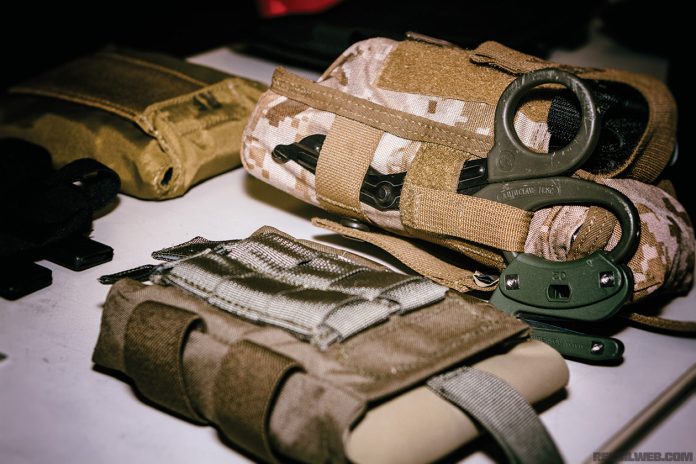LEARN HOW TO POKE HOLES AND HOW PLUG THEM
We live in a pretty messed up world. There are people out there hellbent on doing harm to their fellow humans. In a less-than-perfect world, staying safe often means carrying a firearm.
Being responsible for your personal safety goes beyond being armed. If you or the people around you are injured in a self-defense situation, you may need to administer aid until professional help arrives. Knowing what to do, and having the supplies to do it, could mean the difference between dying on the floor and living to tell the tale.
If you carry a concealed handgun, you’re probably prepared to make holes if the need arises. Unfortunately, few people who regularly tote a CCW are adequately prepared to patch holes if they have to.
Disclaimer: This article is not intended to substitute medical advice or emergency care. Before relying on any IFAK, tourniquet, or any other medical gear, you should seek qualified training on its proper use. Always seek professional medical treatment first before attempting any trauma care techniques.
BEST PRE-MADE IFAKS FOR CONCEALED CARRY
If you don’t have the time to pull together your own custom IFAK, there are several high-quality pre-made options to choose from. Here are a few of our favorites.
Live The Creed EDC Pocket Trauma Kit
Small, easy to carry, and with (almost) everything you really NEED right where you need it. This is the EDC IFAK that several of our editors carry with them every single day. I like it because it covers the extreme and the basics fairly well while staying in a compact unit you can actually take with you.
SWAT TQ isn’t the top of our list for best TQ on the market, but it’s good enough to get the job done and it does a better job of fitting more size limbs than something like a CAT7. When you’re walking the dog or out with the kids, the SWAT will cover all of you.
Something missing is trauma shears, but that’s really because there isn’t any room in the IFAK. Since a good knife is part of my EDC, that’s not a big deal for me.
If you want to plus this up a little, look at the Snake Staff ETQ as an alternative TQ or you can barely fit chest seals in this also. It’s easier to fit if you remove some of the boo-boo medical items, but I prefer having those with me since I use them more often.
SPECS:
- Small, compact medical kit
- Ballistic nylon case
- Hook-and-loop closure
- 1 SWAT tourniquet
- 1 QuikClot bleeding control dressing
- Tan XL nitrile gloves
- 1 bandage kit
- Wound closure strips
- 1 pack of iodine wipes
- 1 pack of alcohol wipes
- 1 tube of Bacitracin ointment
North American Rescue Basic USCG IFAK
North American Rescue is practically synonymous with bleeding control. The company has a wide range of trauma kits and IFAKs for everyone from civilians to law enforcement to EMS.
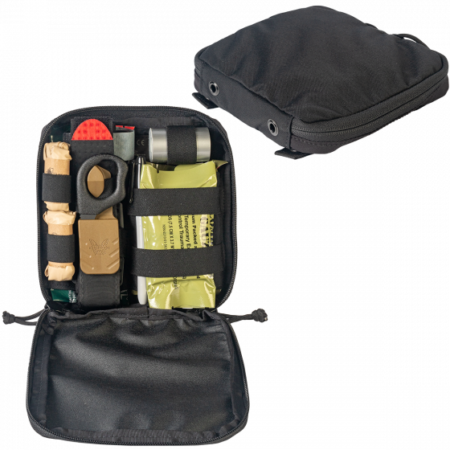
The company’s Basic USCG IFAK includes a CAT tourniquet, hemostatic combat gauze, an emergency trauma dressing, an individual occlusive chest seal, two pairs of nitrile gloves, two inches of duct tape, a rescue hook, and a permanent marker.
Everything comes packed inside a low-profile black nylon bag. While the whole parcel slips easily into a cargo pocket, it does weigh just over one pound.
Rescue Essentials Ankle Trauma Kit
This ankle IFAK from Rescue Essentials allows you to strap all the basics to your ankle for covert carry.
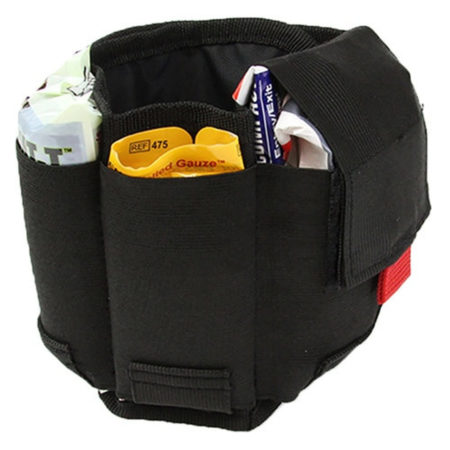
The kit includes a SWAT-T tourniquet, emergency trauma dressing, two compact chest seals, and 48 inches of QuikClot EMS Rolled Gauze.
Rescue Essentials TCCC IFAK Refill Module
This doesn’t come with a fancy pack, but it has everything you need for a good basic IFAK and comes in at a pretty decent price. You can save some money building your own kit, but it requires buying in bulk on some items and savings will be iffy depending on shipping.
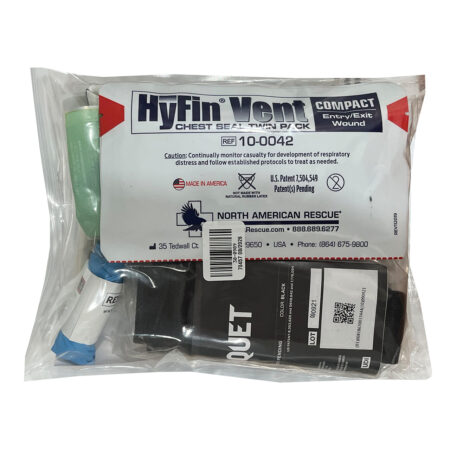
Combine this with your favorite IFAK pouch and you’re good to go. Pro tip, you can save a LOT of money buying pouches from Amazon. They are Chinese-made, but they get the job done and you’re not counting on a pouch to save your life.
WHAT IS AN IFAK?
IFAK stands for “individual first aid kit.” However, the concept differs from the miniature medical kit most families keep in their medicine cabinets to treat minor scrapes and bruises.
The IFAK is actually a military concept. Issuing every warfighter his or her own medical kit allows individuals to provide immediate care to themselves and their wounded battle buddies.
Military IFAKs contain expendable medical items like gauze, bandages, disposable gloves, and a tourniquet, all packed inside a modified MOLLE 100-round SAW ammo pouch.
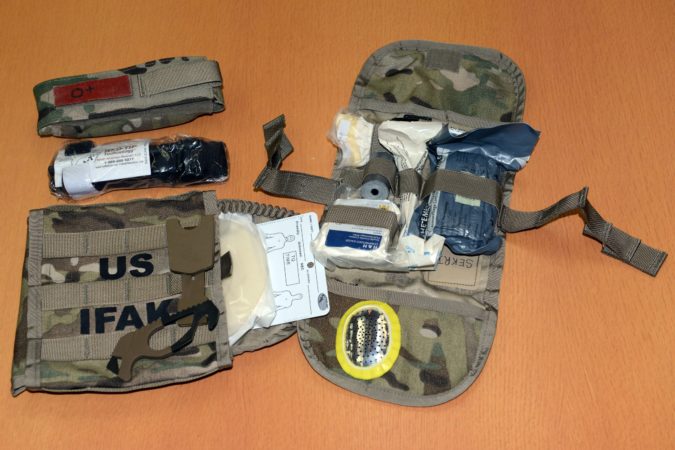
WHY YOU NEED AN IFAK
Emergency Medical Services (EMS) respond to roughly 37 million 911 calls each year. The average ambulance response time is 7-10 minutes. While that might seem pretty fast, it only takes 2-5 minutes to bleed out due to a traumatic injury.
The ability to provide immediate care to yourself or other injured individuals in an emergency situation can make a huge difference in survivability.
HOW TO CARRY YOUR IFAK
Why you should carry an IFAK is pretty much a no-brainer. The logistics of how to carry an IFAK is a whole other story.
If you’re tricked out in a tactical vest covered in MOLLE webbing, you have plenty of real estate for packing an IFAK. However, if you dress like that while you’re running basic errands, you’ll draw a lot of unwanted attention, not just from co-workers or fellow shoppers, either.
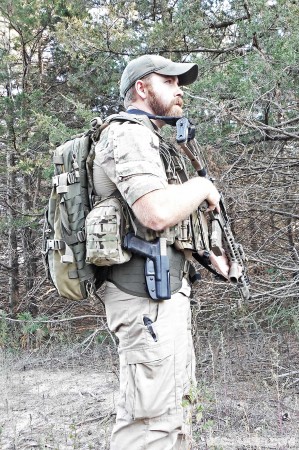
Make a stop at the bank in that kind of garb, and you might be greeted by the county SWAT team on the way out the door.
The ability to fly under the radar is the whole concept of concealed carry. But when you’re wearing street clothes, adding a bulky IFAK to your EDC loadout can make it a lot harder to keep a low profile.
So, where should concealed carriers stow their IFAK? Here is a quick rundown of the most common options.
Pocket Carry
When we think of EDC load-outs, we usually think about all the cool stuff we can jam into our pockets. While an IFAK could potentially fit in some nice, roomy cargo pants, you’re going to have a hard time shoving one into a pair of dress slacks or skinny jeans.
Not only do cargo pants give off that tacti-cool vibe many concealed carriers are trying to avoid, but they also aren’t fitting for every social situation. (Don’t believe me? Try wearing your 5.11s to a wedding rehearsal dinner. Not appropriate. Ask me how I know.)
If you do plan to carry a pocket IFAK, you’ll need to trim it down to just the basics, but whatever you decide to remove, don’t leave that tourniquet at home.
Belt Carry
Attaching an IFAK to your belt solves the pocket problem. Attaching a med pouch to your waistline will give you a bit more storage room for things like an extra tourniquet or two and plenty of hemostatic gauze.
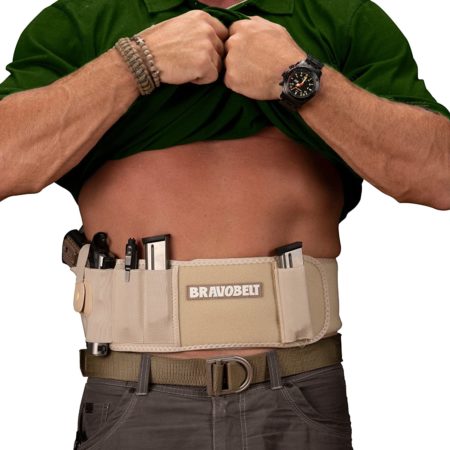
Unfortunately, once you add a medical pouch along with your sidearm and a couple of extra mags, your waistline starts to look like Batman’s utility belt, only bulkier and far less cool. It also isn’t exactly practical if you’re trying to go the “low signature” route.
If you do decide to tote your med kit on your belt, make sure it’s positioned so it won’t interrupt your draw.
Ankle Carry
Want to be discreet, but need more supplies than you can fit in your pocket? Strapping your IFAK to your ankle could be the answer.
Not only will this carry method make you feel like a James Bond badass, but it’s also pretty discreet (unless you’re wearing a kilt or a miniskirt, then all bets are off).
If your ankle IFAK does catch someone’s eye, their brain probably isn’t going to jump straight to first aid. They are more likely to think “ankle monitor,” which could also earn you a few badass points, depending on the scenario.
The truth is, few people look at your ankles unless they are weird or admiring your shoes. That means an ankle IFAK might be the best way for you to maintain gray man status.
Although you can probably fit more supplies in an ankle IFAK than you can in your pocket, lugging around an entire trauma kit on your tarsus probably isn’t going to happen. You’ll still need to streamline your supplies.
Again, don’t leave your tourniquet at home.
Off-Body Carry
Carrying a fully-stocked IFAK on your person isn’t always practical. On-body options can be uncomfortable for all-day wear. They can also get in the way, which can be a game-changer in a dynamic, violent situation.
Toting an IFAK in a backpack, briefcase, purse, or laptop bag is one solution. However, relying on an off-body carry method has its drawbacks. For example, there are a lot of places, like concerts, courthouses, and movie theaters, that won’t let you enter if you’re carrying a bag.
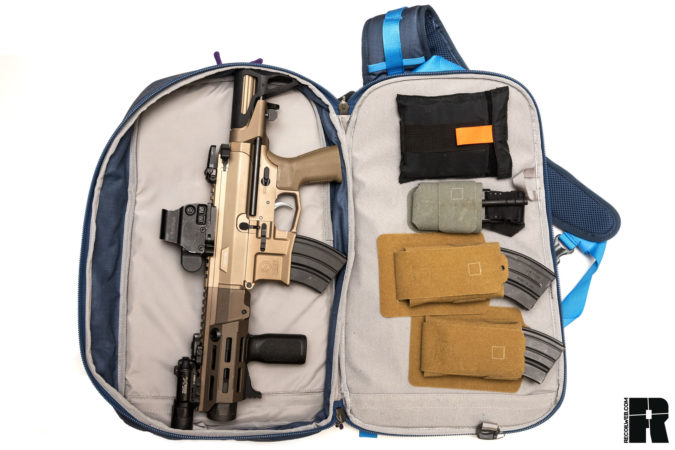
It’s also tempting to leave your bag in the car if you’re just running into the grocery store to grab some bread and milk. If something bad goes down while you’re in the store, you’ll have to get back to your car to retrieve your medical supplies.
If you are suffering from arterial bleeding, you may only have seconds to get to your kit before you pass out. If that kit is in your car, you’re probably screwed.
Having at least a basic kit on your person is the safest bet. You can always keep a backup kit with more supplies in your vehicle.
BUY OR BUILD?
There are a lot of really awesome premade IFAKs on the market today. Sticking one in an online shopping cart and then having it show up at your doorstep a few days later is ultra-convenient.
However, there are some major perks to building your own IFAK. The obvious advantage is that you can personalize the contents of your kit. You can decide to leave out the laxatives or add some extra aspirin, depending on your needs and priorities.
Piecing together your own kit will also help you familiarize yourself with its supplies. You don’t want anything taking up space in your kit that you don’t know how to use properly.
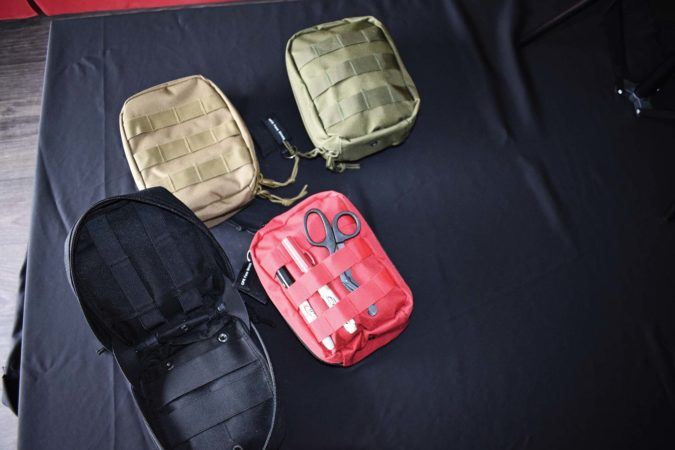
Of course, nothing says you can’t start with a premade IFAK and then embellish the contents with a few extra supplies.
Warning: Buyer Beware
Whether you build or buy a kit, make sure you use a trusted retailer to source your goods. I would especially recommend that you do not use Amazon for anything medical-related.
Amazon, and some other mega-volume retailers, have a standard practice of batching all items with the same SKU into the same bins for storage. With the huge influx of knock-offs, it is not uncommon for reputable products and knock-offs to get mixed in together.
When your life might depend on it, you don’t want to run the risk of paying for a real CAT7 tourniquet only to receive a knock-off that will break when you go to apply it.
If possible, I prefer to buy right from the source for medical gear. North American Rescue is my first stop, no matter what. You might not get the rock-bottom lowest price, but you will get a 100% trustworthy product.
WHAT GOES IN THE IFAK
IFAK MUST-HAVE:
- Tourniquet
- Wound Packing Gauze
- Compression Bandage
- Chest Seals
- Trauma Shears
- Disposable Gloves
IFAK Good To Have:
- Adhesive Band-aids
- Mylar blanket
- Medical tape
- Burn dressing
- Disinfectant (wipes or gel)
- Sharpie
Advanced Training Required:
- Splint
- Nasopharyngeal airway
- Chest decompression needle
Being prepared for bad things is the driving motivation behind concealed carry. That mindset should extend to your IFAK. It should have more than basic boo-boo stuff.
When the feces hit the flabellum, you want appropriate supplies to keep yourself and the people around you alive until help arrives.
While it’s always tempting to cut corners and pinch pennies, don’t do it on medical supplies. Although you hope you’ll never need to use it, if you ever do, you’ll want quality medical gear you can count on.
Tourniquet
An estimated 40 percent of trauma-related deaths worldwide are due to bleeding, so a lot of your concealed carry IFAK should focus on ways to stop or slow blood loss. The first essential piece of gear is a tourniquet. Honestly, you should never leave home without one.
Consider it a mission essential item. If you carry nothing else, carry a tourniquet.
Carrying a tourniquet next to your CCW is a solid choice. Several holster companies offer options that allow you to tote a tourniquet where you might normally carry a spare mag.
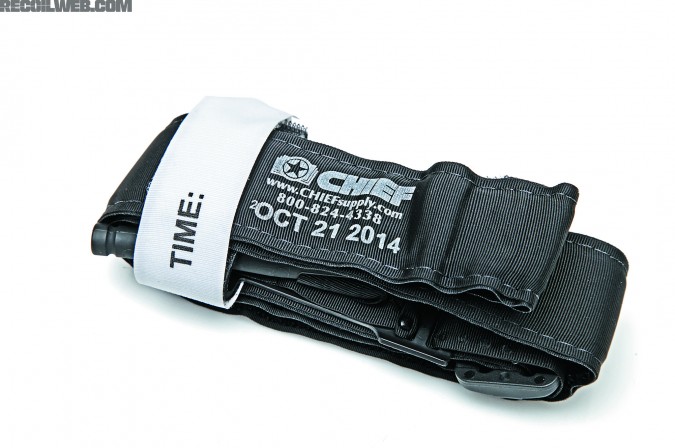
Combat application tourniquets (CAT) have saved plenty of lives on the battlefield, and they are far more effective and reliable than anything you can improvise.
If you’re bleeding from a gunshot wound, the last thing you want to do is MacGyver a tourniquet. Find a tourniquet approved by the CoTCCC (Committee on Tactical Combat Casualty Care). There are a ton of low-quality clones out there, so make sure you are carrying one that made the approved list.
Wound Packing Gauze
Although wound packing gauze isn’t recommended for wounds to the chest or abdomen, it can help stall bleeding of penetrating wounds to the extremities.

Plain wound packing gauze is honestly all you need and it’s cheap. Hemostatic gauze is a fancy version that is treated with a hemostatic agent like QuikClot. It’s an order of magnitude more expensive and the benefits are questionable.
Recent studies (source one, source two) have called into question how effective hemostatic gauze really is, especially in “care under fire scenarios”.
That said, most of these studies assume the person providing treatment is trained in wound packing. While not hard, this is a skill that much of the public lacks. If you’re looking to save money, normal Z-Fold gauze is a lot less expensive. But if you want to spend some money and hedge your bets, hemostatic gauze might help.
Compression Bandage
Once you’ve stuffed a gunshot wound with gauze, you’ll need to wrap the dressing with a compression bandage.
You can go simple with an elastic bandage wrap like the kind the school nurse used to bind teenage ankles twisted during gym class.
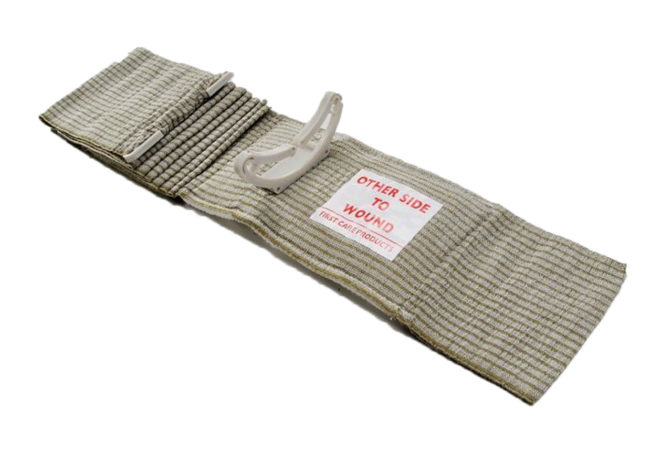
However, Israeli bandages work better. It’s basically a sterile dressing and a compression bandage rolled into one convenient package. Israeli bandages include a pressure bar that applies 30 pounds of pressure to the wound to help stall excessive bleeding until help arrives.
Chest Seals
Chest seals are used on penetrating wounds to (you guessed it) the chest. An extra, unwanted hole in the chest cavity leaks air into the space between the internal lining of the torso and the surface of the lungs. When too much air enters that gap, it results in a collapsed lung.

As the name implies, chest seals are designed to seal the extra hole so the victim can breathe properly. While you can improvise a chest seal using two Vaseline gauze pads and some duct tape, purpose-built chest seals (like the Compact Hyfin Vent made by North American Rescue) are simpler and easier to use.
Since we’re talking chest seals, it is worth noting that penetrating wounds to the chest (like gunshots) often result in two wounds — an entry wound and an exit wound. With that in mind, most chest seals come in two-packs.
Trauma Shears
It’s hard to treat wounds you can’t see. A good set of trauma shears will slice through thick jeans and other constrictive clothing, giving you better access to the injuries underneath.

They’re also just really useful for just about everything. Seat belts, battle belts, Amazon packages, and more.
Disposable Gloves
When administering aid, you need to consider both sides of the wound. That means you don’t want to pick up germs from the wounded, but you also don’t want to introduce any to the victim.
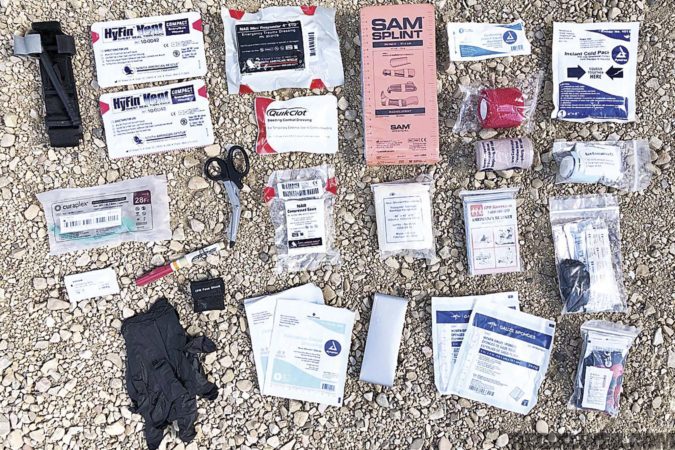
A basic pair of disposable gloves is a good way to keep things as sterile as possible. Every IFAK should contain at least a couple of sets so you can swap out dirty gloves when you need to.
GOT SKILLS?
Firearms people are notorious gear junkies. While acquiring new toys is exceedingly fun, throwing a bunch of gear at a problem rarely solves it.
Having a well-stocked IFAK isn’t going to do much good if you don’t know how to use it. Gear, no matter how fancy or prolific, should never be considered a substitute for skills.
Sign up for a first-aid course and learn basic CPR. If you want to take it one step further, take a basic EMT or TCCC (Tactical Combat Casualty Care) course.
The really cool thing about skills is that you can take them with you everywhere, and they don’t weigh a damn thing.
Like shooting skills, first aid skills are perishable, so practice what you’ve learned regularly.
Since our founding in 2012, RECOIL remains the premier firearms lifestyle publication for the modern shooting enthusiast. We deliver cutting-edge coverage of guns, gear, accessories and technology. We go beyond basic reviews, providing no B.S. buyer’s guides, hands-on testing and expert analysis on everything from firearms and survival equipment to watches and vehicles.
Our reviewers are the backbone of our operation and come from diverse shooting backgrounds: Former law enforcement, military veterans, competitive shooters, seasoned hunters and plain old firearms enthusiasts. Furthermore, we’re not just gun experts, but dedicated journalists who adhere to the strictest standards of our profession.
At RECOIL, editorial independence is the foundation of everything we publish and the cornerstone of reader trust. Our editors, writers and content creators make all editorial decisions independently, free from outside influence. That boils down to: advertisers don’t dictate our coverage, the outcomes of our reviews or what we recommend in our buyer’s guides. First and always, our commitment is to our audience—ensuring every review and article is accurate, unbiased, and driven by real-world experience.
Whether you’re selecting your next firearm, upgrading your gear, or exploring the latest innovations in the shooting world, RECOIL provides the trusted insights you need to make informed decisions. Learn more about our Editorial Standards and how we review products.
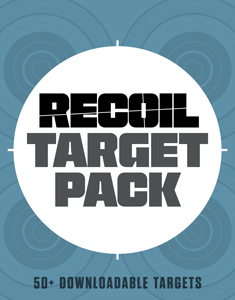
NEXT STEP: Download Your Free Target Pack from RECOIL
For years, RECOIL magazine has treated its readers to a full-size (sometimes full color!) shooting target tucked into each big issue. Now we’ve compiled over 50 of our most popular targets into this one digital PDF download. From handgun drills to AR-15 practice, these 50+ targets have you covered. Print off as many as you like (ammo not included).
Get your pack of 50 Print-at-Home targets when you subscribe to the RECOIL email newsletter. We’ll send you weekly updates on guns, gear, industry news, and special offers from leading manufacturers – your guide to the firearms lifestyle.
You want this. Trust Us.
Read the full article here


